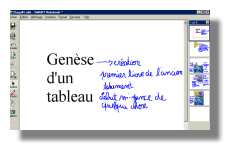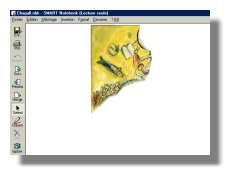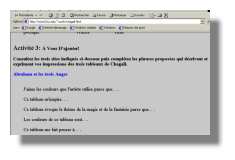“Genesis of a painting”
Goals :
Analyse a painting and find the traces of judeo-christian culture.
Documents
:
The Creation of man , by Marc
Chagall, link toward the Marc Chagall museum in Nice.
Situation of the course : This course takes
place in a sequence untitled Tales of the
Creation. Before this course, the students will have read extracts of the
Old Testament, Ovide’s Metamorphoses, and an american indian myth reported by
Richard Erdoes.
Development of the course :
|
To begin, we define the meaning of
the word Genesis : name of the
first book of the Old Testament, which contains the tale of the Creation, but
also all the things that contribute to create something or the way something
has taken shape. |
|
|
The SMARTboard then allows us
to progressively discover the elements of the painting, which is divided into
three zones. As we discover the different parts, the students write what they see
and start to give their hypothesis. |
|
|
With a marker, on the SMARTboard and on a screencopy, we can lay out
the line the eye follows, from the top
to the bottom, and from left to right.
If we read this painting like a book, which book would it be? The students should then find the
source of inspiration for the painting among the extracts they’ve read
in class, and must precisely quote the text as a legend and give the painting
a title. Even though this painting
doesn’t aim to illustrate but to re-create the scene, all the paintings of the
Biblical Message are essentially narrative, which makes it easy to compare
the texts and the images. Once we have related the painting to the text, and
found the elements that compose it, we can consider the poetic and artistic
dimension. |
|
|
A few minutes will be given to the students so they can express what they
have “seen” while reading the text and what struck them in Chagall’s painting
: the animals of the farm, the couples, the fact there is no gravity, the
intensity of the colors will be reminded as caracteristics of the artist’s style, Marc Chagall for whom
the Bible was “ the greatest source of poetry of all times ”. |
After stating that the reading of the Old-Testament nurtured the work
of the artist, searching the site of the Museum Chagall of Nice on the SMARTboard,
the students can find new elements in Chagall’s biography, sketches, drawings
and other paintings to explain the genesis of his art.
The end of the course will propose a writing session in which the
student will write an essay about a painting chosen in the Biblical Message.



